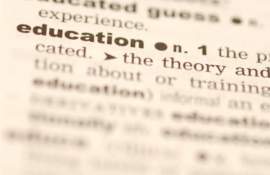
Make Sure You Know the Laws in School

After events such as the 1999 "Columbine High School Massacre" in Colorado near Littleton, the urgency of intervention efforts to prevent school shootings are more than apparent among educators in public schools as of late more than ever. With the idea that sometimes drastic proactive measures are needed, school officials and administrators within districts have sought to expand staff members' rights to search lockers for evidence of wrongdoing. However, whether or not this is a violation of children's Fourth Amendment protection from unreasonable search and seizure is a point of controversy.
The concept of what constitutes an illegal search was notably brought up in 1985 by the case of New Jersey v. T.L.O. The lengths to which school officials can go in the interest of public safety continues to be fought in and out of school lockers. On a related note, the Supreme Court in its decision in Safford Unified School District v. Redding found that a strip search with no evidence that such measures will lead to evidence of a crime is an undue violation of the Fourth Amendment.
However, as ruled by lesser courts in other cases, evidence of a crime is not always a requirement for all-purpose searches. One particular 1993 Wisconsin Supreme Court case heard arguments over whether or not a search of one hundred or so lockers in a school performed in response to vague rumors of a threat was justified, and whether or not the conviction of a child found to have a loaded weapon and drugs in his possession should be overturned.
Ultimately, the Court found that the search did not violate the Fourth Amendment and that the school gave fair warning that lockers (rationalized to be in the public domain as property of the school) could be searched at will. Rulings such as this raise definite concerns about the erosion of the right of privacy in schools.
Drug Testing
While some people might be adamant about implementing widespread drug testing for professional athletes, with regard to student athletes/participants in middle school and high school sports and other extracurricular activities drug testing is a different ballgame. Random drug testing for juvenile athletes and non-athletes alike is a complicated issue.
The Supreme Court has weighed in on the subject as recently as 2002 when, in the case of Board of Education v. Earls, it decided that schools could make participation in all after-school activities contingent on passing a urine test. Previously, only athletes specifically were mandated to have to undergo such testing. In finding as it did, the Supreme Court broadly suggested that drug testing in the aim of protecting students and preserving a competitive balance was not a violation of the Fourth Amendment to the Constitution.
On top of this and outside Board of Ed. v. Earls, drug testing in public schools is conducted with the best interests of students in mind, trying to find offenders so that they and their families can work together to effect a plan of counseling and rehabilitation. Still, there are those who criticize random drug testing purely on the basis of its impracticality. For one, drug testing in schools may be a rather pricey way of weeding out a few drug users, especially if it used for all students and teachers.
Even when drug testing is successful in terms of identifying drug users, these results aren't always the best of news. Numerous analyses, most notably a large-scale 2003 University of Michigan study have shown that random drug testing had little effect on prevention efforts, and for certain classes of drugs, because students thought they could not reliably be detected, use actually increased.
Freedom of Speech
Given the tug of war between the freedom of speech cases such as Hazelwood v. Kuhlmeier, affirming a school's ability to edit objectionable content in its own publications, and Bethel School District v. Fraser in 1987, giving a school permission to punish a student for lewd/suggestive speech, helped get the idea across that educators could still reserve the right to keep its halls in check.
Still, within the realm of creative arts and outside of the school's walls, the intrusion of the schools in these spheres of influence is more controversial in today's America. In the interest of preventing abuse, suicide, school shootings, and other forms of violence, school officials have intervened in children's and families' affairs after reading poetry/stories and looking at pictures depicting death and destruction created in class. Even when this material is explored out of concern for a child, concerns about artistic license and the right to privacy may still remain, especially if these "warning signs" are a false alarm after all.
Schools have also been criticized and litigated against for suspending students for acts contrary to school rules committed off school grounds. Punishing children for threatening/mocking language directed at other students and educators through public Internet forums has been questioned by observers with an interest in civil liberties.
In the 2007 case of Morse v. Frederick, though the Supreme Court found against a child who displayed a message on a sign reasoned to be an endorsement of illegal drugs at an out-of-school event, dissenters argued the suspending school did not have the authority to do so.
School Uniforms and Freedom of Expression
The institution of school uniforms in public schools is often portrayed as a restriction on freedom of expression, though this is a rather narrow-minded approach to the subject of First Amendment freedoms. Indeed, there is a lot to consider regarding school dress code policies, freedom of expression, and school uniforms.
Going back to Tinker v. Des Moines Independent Community School District, this 1969 case was more than the sum of its parts, as it is a barometer for standards of acceptability in student expression. In ruling that a few students' right to wear armbands in silent protest of America's involvement in the Vietnam War was protected by the Bill of Rights, Tinker became a symbol of the fact that children have rights to express themselves, even in public places run by adult administrations.
However, these are not unqualified rights. Students must handle and dress themselves in a way that is befitting of proper conduct. "Provocative" clothing deemed too revealing or inappropriate may be punishable under school rules. As a means of sidestepping these concerns, and in turn, promoting good educational and civic values, school uniforms are growing in acceptance and use in public schools.
From students and non-students alike, charges that school uniforms are restrictive dress codes have come under fire. In this event, direct comparison between students' dress and freedom of expression is warranted, as the children themselves would allege the former is obscuring the latter. Moreover, there are serious doubts as to the efficacy of school uniforms in the very areas they are supposed to address. Detractors insist these are merely cosmetic changes that do little to address the roots of the more serious issues facing our nation's schools, such as poor performance in schools and the diminishing role of the family in educating youths.
School Prayer
The distinction between the United States as an implicitly or explicitly Christian country is all too important. While sentiments such as "one nation, under God" included in the Pledge of Allegiance point to an undercurrent of Christian faith in everyday America today, by virtue of the Establishment Clause the case of Engel v. Vitale held that the inclusion of "Almighty God" and other language that promotes the views of one particular class of religions in a morning salutation is unconstitutional as a violation of the Establishment Clause.
While the majority decision of Engel v. Vitale was a landmark decision, it by no means was a final ruling regarding attempts of schools and legislators to try to infuse Christian prayer into public school functions. The Supreme Court was called to lend its opinion on a reprisal of this debate set in motion by the events leading up to Santa Fe Independent School Dist. v. Doe.
The original complaint was in response to the repeated allowance of students to lead prayers over the loudspeakers at high school football games. In all fairness, the ideas that these prayers were student-led and that attendance at these games was voluntary provided some contrast to the Engel case. Nonetheless, the unifying and relevant principle is that prayer oriented towards a specific faith was being recited on school grounds. This too failed the Establishment Clause test. Some have even called for a Constitutional Amendment allowing for the legality of prayer in schools, but this bill's myriad dissenters highlight, among other things, that this would violate the First Amendment in itself.
Religion in School
Though students and teachers are not expected to check their faith at the schoolhouse door, the context in which individuals practice that religion in American public schools must be specifically defined, as public education is a secular function of society. Certainly, educators must be on guard from allowing their classroom to turn into a pulpit.
As far as lessons go, teachers may only approach the subject of religion from the purview of general information about these religions or as a subset of larger discussions of history, art and other similar fields, and may not allow children to use oral reports as a proverbial soapbox for their religious beliefs or as a means of converting the other students.
Moreover, any such discussion of religion must not be done in an intimidating manner. No matter whether it occurs in class or not, children should not be put in pressure-filled "or-else" situations regarding their attendance at, say, church events or subscription to certain value systems.
For all these restrictions, pupils and educators should be permitted forums to express their beliefs. Within class, it is imprudent for a teacher to censor a child's religiously-charged views on a topic as long as they are respectful of opposing stances (e.g. a pro-life statement amidst a discussion of pregnancy/abortion).
Intelligent Design vs. Evolution
Noting the religious overtones of intelligent design theory and the secular tenor of the argument for natural selection, the two are commonly made to represent opposing sides of faith and science, with schools serving as the battleground. The battle of whether or not to teach evolution in public schools rose to national prominence after the Scopes Monkey Trial in the 1920s. In this precursor to the modern debate, evolution squared off against Fundamentalist creationism, which declared that God was responsible for the creation of man, not natural selection/evolution.
Pure creationism made one last gasp to weave its way into curricula in the 1980s, and while its proponents did not vehemently call for prohibitions against teaching evolution in schools as the Fundamentalists did, they still sought to make it mandatory to teach creationism alongside evolution as an alternative theory. However, as of its majority ruling in Edwards v. Aguillard, the Supreme Court disagreed with either setup, ruling it unconstitutional to teach creationism in public schools because its promotion of Christian values runs against the Establishment Clause of the First Amendment.
In 2005, meanwhile, Kitzmiller v. Dover ruled specifically against the teaching of intelligent design in its district along similar lines. For some objective observers, though, this was a bittersweet finding of the Court, as although they may not have accepted intelligent design as science (most scientists, in fact, do not), they objected that intelligent design and creationism are actually two related but different concepts; intelligent design does not expressly name God as the higher power responsible for evolutionary changes.
NEXT: Understanding Freedom of Speech





















